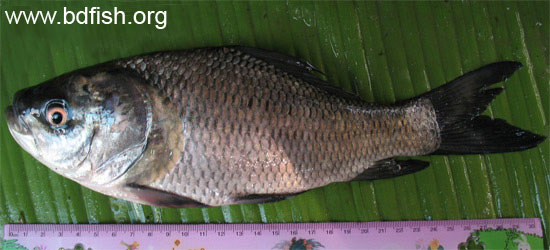
Systematic position:
Phylum: Chordata
Class: Actinopterygii (Ray-finned fishes)
Order: Cypriniformes (Carps)
Family: Cyprinidae (carp and minnows)
Genus: Catla
Synonyms: Cyprinus catla (Hamilton, 1822), Gibelion catla (Hamilton, 1822) and Cyprinus abramioides (Sykes, 1839).
Common names: Catla, Katol (Bangladesh); Catla (Fishbase); Indian Major carp, Baudhekra, Catla, Chepti, Bacha, Tambra, Karakatla (India).
Distribution: Bangladesh, India, Pakistan, Nepal, Myanmar. Also in Sri Lanka, China etc. countries.
Conservation status: Non threatened.
Morphology: Body compressed with comparatively broad head. Mouth wide with thick and broad lower lip. Dorsal profile more convex than that of ventral profile. Barbels absent. Dark gray above, silvery on sides and abdomen. Fins are blackish and pectoral pale. Lateral line complete with 40-43 scales.
Head 27.1% of standard length (SL) and 25.0% of total length (TL). Height 38.3% of SL and 35.3% of TL. Diameter of eye 15% of head length (HL).
Fin formula: D. 18; P1. 20; P2. 9; A. 8
Maximum length and Weight: 180 cm (Day, 1878), 30 cm (Bhuiyan, 1964), 120 cm (Hussain, 1999), 96.7 cm (Rahman, 2005). Highest length measured 55 cm from Chalan beel (Bangladesh) in 2007.
Rahman (1989) recorded 19.8 kg fish from Chandpur (Bangladesh).
Habitat and niche: Found in freshwater bodies, rarely in brackish water; some common habitats are- ponds, ditch, canals, beels, floodplains, haors, baors (oxbow lakes), rivers, lake etc. Niche is surface layer of water body.
Food and feeding: Takes food from surface layer of habitat. It is a non-predatory fish and its feeding is restricted to the surface and mid waters (Talwar and Jhingran, 1991). Feed on both natural and supplementary feeds. Feeds on zooplankton mainly and also well habituated in taking rice bran, wheat bran, mustard oil cake and other supplementary feed under aquaculture system.
Breeding: Naturally breeds in flowing water bodies, especially in rivers, and floodplains during rainy season. Attains sexual maturing at the stage of two years. Breeding time recorded rain season in Chalan Beel (Bangladesh). The spawning season coincides with southwest monsoon in Bangladesh and Northern India where it lasts from May to August (Talwar and Jhingran, 1991). According to Rahman (2005) this species attains sexual maturity at ages 3 to 5 years.
Artificially propagation by hypophysation successfully practiced in hatcheries by using PG (Pituitary Gland) hormone.
Economic importance: Used as culture species in aquaculture. Used as food fish. Often used as game fish in Bangladesh but widely used in other countries. Always marketed in fresh condition. This species command a good market price and consumer demand.
Harvesting and production: Harvesting is done by using rod and line. Large scale harvesting is done with different types of fishing nets especially seine nets.
In Bangladesh, total production (in the year 2007-2021) of this fish was 5,721 kg from Beels of Bangladesh; 171 kg from Kaptai Lake and 17.42% of total pond production (FRSS, 2009).
References:
Bhuiyan, A.L., 1964. Fishes of Dacca, Asiat. Soc. Pakistan, Pub. 1, No. 13, Dacca, pp. 30-32.
FRSS (Fisheries Resources Survey System), 2009. Fishery Statistical Yearbook of Bangladesh 2003-2004, 21st ed., Department of Fisheries, Ministry of Fisheries and Livestock, Bangladesh, 42 p.
Hamilton, F., 1822. An account of the fishes found in the river Ganges and its branches, Edinburgh & London, pp. 1-405.
Hussain, M.M., 1999. Fishes and Fisheries of the River Atrai in Rajshahi with Reference to its Limnology, unpublished Ph.D. thesis, Department of Zoology, University of Rajshahi, Bangladesh, pp. 5-200.
Rahman, A.K.A., 1989. Freshwater Fishes of Bangladesh, 1st edition, Zoological Society of Bangladesh, Department of Zoology, University of Dhaka, Dhaka-1000, pp. 138-139.
Rahman, A.K.A., 2005. Freshwater Fishes of Bangladesh, 2nd edition, Zoological Society of Bangladesh, Department of Zoology, University of Dhaka, Dhaka-1000, pp. xviii -263.
Sykes, W. H., 1839. On the fishes of the Deccan. Proc. Zool. Soc. Lond., pp. 157-165.
Talwar, P.K. and A.G. Jhingran, 1991. Inland Fishes of India and Adjacent Countries, Vol. I, Oxford & IBH Publishing Co. Pvt. Ltd. New Delhi-Calcutta, pp. 163-165.
Visited 10,569 times, 3 visits today | Have any fisheries relevant question?
